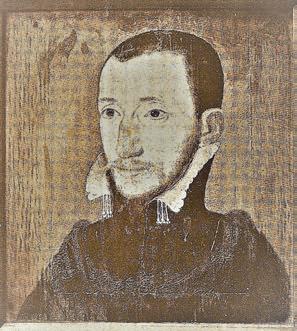
3 minute read
ANNE DACRE, COUNTESS OF ARUNDEL
Anne was born in 1557 in Carlisle. Her mother having died in childbirth, Anne was brought up by a Catholic grandmother, doubtless the influence that led to her own conversion to Catholicism at the age of twenty five, in Arundel Castle. At twelve a marriage had been arranged between her and Philip Howard, Earl of Arundel, formalised two years later when the couple reached the age of consent. Anne’s conversion led to her being put under house arrest by Queen Elizabeth, but this did nothing to diminish her efforts to persuade her husband to join her in the faith. Philip had effectively abandoned his wife for the high-life of Elizabeth’s Court, and must have seemed an unlikely convert, but his experience of witnessing the trial of the Jesuit priest Edmund Campion so impressed him that he made the decision to risk the Queen’s ire by joining the Catholic Church.
For Elizabeth this was a betrayal. In 1570, at a time when her throne was genuinely under threat, Pope Pious V had excommunicated the Queen, and instructed English Catholics not to recognise her sovereignty. Philip’s conversion therefore made him a suspect in her eyes, and Anne the agent of his betrayal. Philip was imprisoned in the Tower of London, Anne banished from London, their titles and properties forfeit. It was in rented rooms in Essex that their son Thomas was born, and for eleven years until Philip’s death in 1595 Anne was forbidden any kind of visit to her increasingly frail husband.
Advertisement
The pair of windows at the west end of the Cathedral, depicting St Philip and Anne, were installed in 1986 in memory of George Vigar. The windows were designed by John Lawson (1932-2009), chief artist for the internationally renowned Goddard & Gibbs Studios, London, adding to the Cathedral’s fine collection of stained-glass.
Anne, opposite, is shown in her usual widow’s black, but with an ornate decoration on her breast, the significance of which is uncertain. In her hand she holds the scroll of the foundation of the Jesuit House in Ghent (now part of the University of Ghent), which she helped to establish.
Anne must have been a resourceful character as well as being a deeply pious woman, and with the death of Elizabeth in 1603 and the accession of King James she was able gradually to reclaim her possessions, and restore her place in society, at the same time as practising her Catholic faith. As well as her rigorous daily religious observances she wrote extensively, memoirs and poetry (now little read beyond the confines of American university libraries), and her finances must have become increasingly sound for her to carry out the good works for which she became renowned:
‘Her charity and alms-deeds were unfailing: she nursed the sick, rescued orphans, provided poor girls with their marriage portions; no one in need ever called her in vain. Twenty poor people were fed daily from her house, and on three days a week near a hundred came from the villages around to share the dinner specially prepared for them. Her love of little children increased with her old age and she took much delight in making simple feasts for them’.
Despite her personal austerity, Anne’s household sounds cheerful, and there are delightful descriptions of her, even when ill in bed, handing out pieces of cake to poor children. By the end of her life she had fully recovered her status, if not her titles, and in her final illness Charles I ‘sent constantly to enquire for her, and told a friend that he prayed every day for her health and welfare’. She died in 1630, having outlived her husband by thirty five years.
The Remains Of St Philip Howard
In 1623, twenty eight years after Philip’s death, Anne was able to have his remains transferred from his father’s tomb in London to the Fitzalan Chapel in Arundel. In the inscription on his iron coffin she had written ‘The venerated remains of Philip, Earl of Arundel and Surrey, were deposited in this chest by the care of his well-beloved wife Anne, when, by the signal piety of his son Thomas, permission was obtained from King James.’
The ‘signal piety of his son Thomas’ was wishful thinking; Anne was devastated by Thomas’s cavalier attitude towards his faith, and the cheerfulness with which he abandoned it to further his political career. But the remains of Arundel’s saint were in safe keeping, in the Fitzalan Chapel at the time of Philip’s beatification in 1929, and moved to Arundel Cathedral following his canonisation in 1970 and the re-dedication of the Cathedral in his name.



